check engine FIAT FREEMONT 2011 Owner handbook (in English)
[x] Cancel search | Manufacturer: FIAT, Model Year: 2011, Model line: FREEMONT, Model: FIAT FREEMONT 2011Pages: 267, PDF Size: 5.16 MB
Page 223 of 267
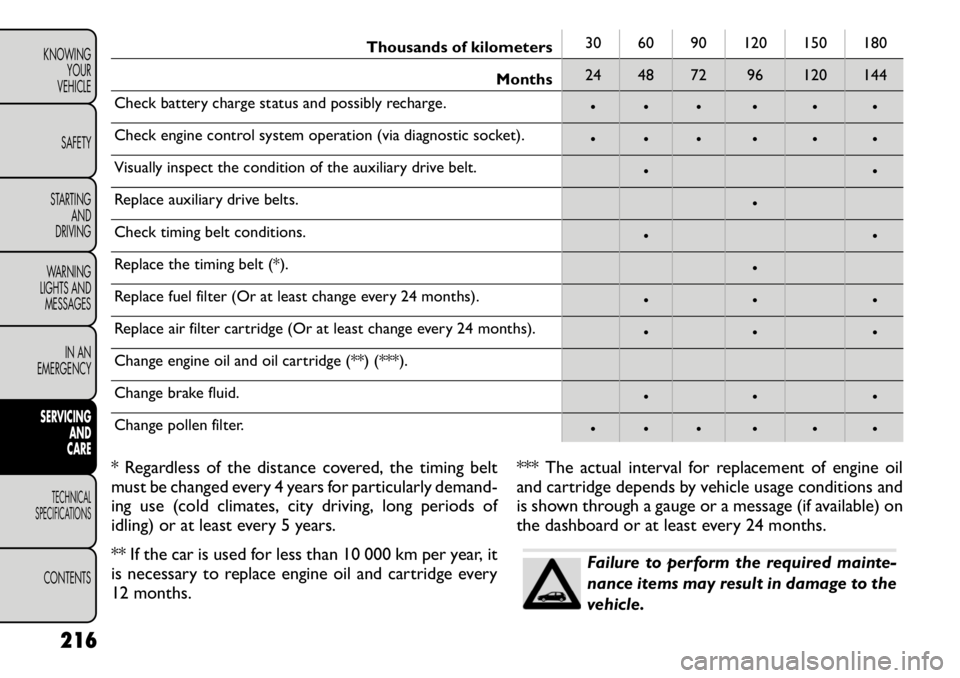
Thousands of kilometers30 60 90 120 150 180
Months 24 48 72 96 120 144
Check battery charge status and possibly recharge. • • • • • •
Check engine control system operation (via diagnostic socket). • • • • • •
Visually inspect the condition of the auxiliary drive belt. • •
Replace auxiliary drive belts. •
Check timing belt conditions. • •
Replace the timing belt (*). •
Replace fuel filter (Or at least change every 24 months). • • •
Replace air filter cartridge (Or at least change every 24 months). • • •
Change engine oil and oil cartridge (**) (***).
Change brake fluid. • • •
Change pollen filter. • • • • • •
* Regardless of the distance covered, the timing belt
must be changed every 4 years for particularly demand-
ing use (cold climates, city driving, long periods of
idling) or at least every 5 years.
** If the car is used for less than 10 000 km per year, it
is necessary to replace engine oil and cartridge every
12 months. *** The actual interval for replacement of engine oil
and cartridge depends by vehicle usage conditions and
is shown through a gauge or a message (if available) on
the dashboard or at least every 24 months.
Failure to perform the required mainte-
nance items may result in damage to the
vehicle.
216
KNOWING YOUR
VEHICLE
SAFETY
STARTING AND
DRIVING
WARNING
LIGHTS AND
MESSAGES
IN AN
EMERGENCYSERVICING AND
CARETECHNICAL
SPECIFICATIONSCONTENTS
Page 224 of 267
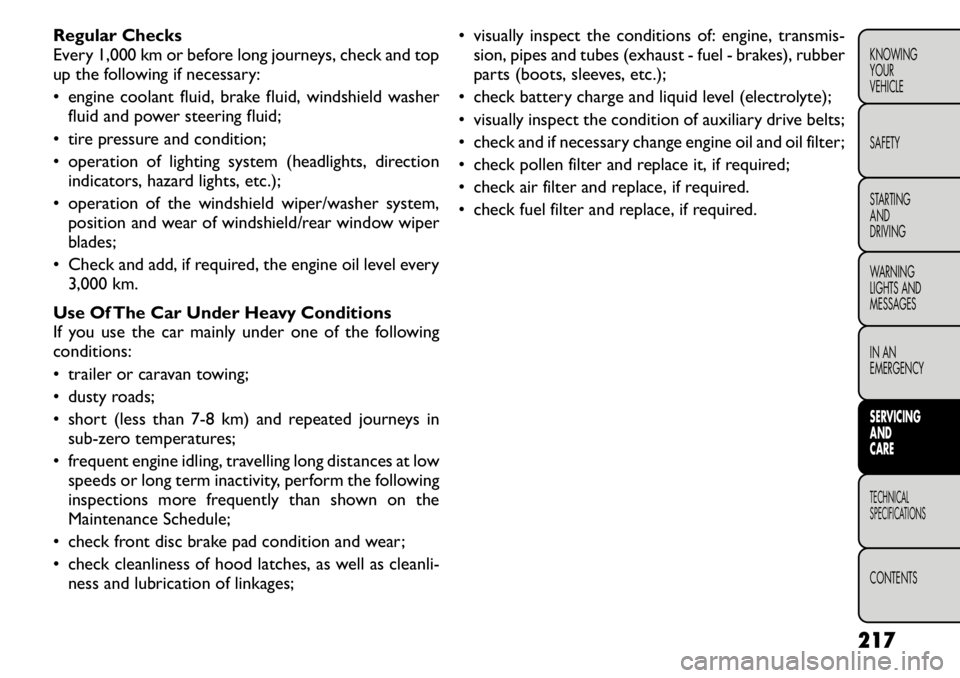
Regular Checks
Every 1,000 km or before long journeys, check and top
up the following if necessary:
• engine coolant fluid, brake fluid, windshield washerfluid and power steering fluid;
• tire pressure and condition;
• operation of lighting system (headlights, direction indicators, hazard lights, etc.);
• operation of the windshield wiper/washer system, position and wear of windshield/rear window wiper
blades;
• Check and add, if required, the engine oil level every 3,000 km.
Use Of The Car Under Heavy Conditions
If you use the car mainly under one of the followingconditions:
• trailer or caravan towing;
• dusty roads;
• short (less than 7-8 km) and repeated journeys in sub-zero temperatures;
• frequent engine idling, travelling long distances at low speeds or long term inactivity, perform the following
inspections more frequently than shown on the
Maintenance Schedule;
• check front disc brake pad condition and wear;
• check cleanliness of hood latches, as well as cleanli- ness and lubrication of linkages; • visually inspect the conditions of: engine, transmis-
sion, pipes and tubes (exhaust - fuel - brakes), rubber
parts (boots, sleeves, etc.);
• check battery charge and liquid level (electrolyte);
• visually inspect the condition of auxiliary drive belts;
• check and if necessary change engine oil and oil filter;
• check pollen filter and replace it, if required;
• check air filter and replace, if required.
• check fuel filter and replace, if required.
217
KNOWING
YOURVEHICLE SAFETY
STARTING ANDDRIVING
WARNING
LIGHTS AND
MESSAGES
IN AN
EMERGENCYSERVICING AND
CARETECHNICAL
SPECIFICATIONSCONTENTS
Page 226 of 267
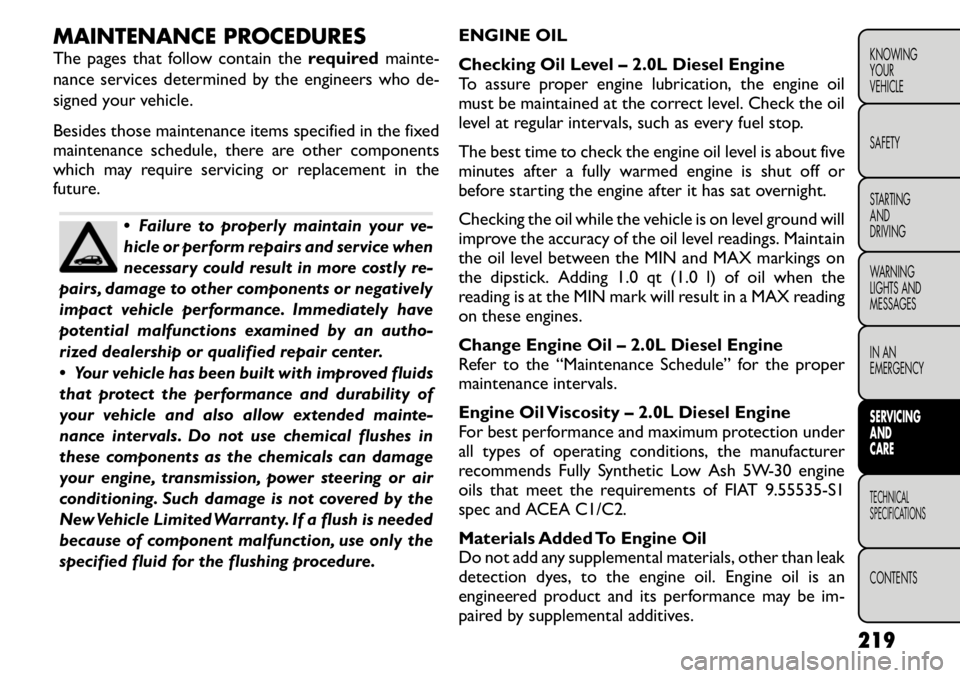
MAINTENANCE PROCEDURES
The pages that follow contain therequiredmainte-
nance services determined by the engineers who de-
signed your vehicle.
Besides those maintenance items specified in the fixed
maintenance schedule, there are other components
which may require servicing or replacement in the
future.
Failure to properly maintain your ve-
hicle or perform repairs and service when
necessary could result in more costly re-
pairs, damage to other components or negatively
impact vehicle performance. Immediately have
potential malfunctions examined by an autho-
rized dealership or qualified repair center.
Your vehicle has been built with improved fluids
that protect the performance and durability of
your vehicle and also allow extended mainte-
nance intervals. Do not use chemical flushes in
these components as the chemicals can damage
your engine, transmission, power steering or air
conditioning. Such damage is not covered by the
New Vehicle Limited Warranty. If a flush is needed
because of component malfunction, use only the
specified fluid for the flushing procedure. ENGINE OIL
Checking Oil Level – 2.0L Diesel Engine
To assure proper engine lubrication, the engine oil
must be maintained at the correct level. Check the oil
level at regular intervals, such as every fuel stop.
The best time to check the engine oil level is about five
minutes after a fully warmed engine is shut off or
before starting the engine after it has sat overnight.
Checking the oil while the vehicle is on level ground will
improve the accuracy of the oil level readings. Maintain
the oil level between the MIN and MAX markings on
the dipstick. Adding 1.0 qt (1.0 l) of oil when the
reading is at the MIN mark will result in a MAX reading
on these engines.
Change Engine Oil – 2.0L Diesel Engine
Refer to the “Maintenance Schedule” for the proper
maintenance intervals.
Engine Oil Viscosity – 2.0L Diesel Engine
For best performance and maximum protection under
all types of operating conditions, the manufacturer
recommends Fully Synthetic Low Ash 5W-30 engine
oils that meet the requirements of FIAT 9.55535-S1
spec and ACEA C1/C2.
Materials Added To Engine Oil
Do not add any supplemental materials, other than leak
detection dyes, to the engine oil. Engine oil is an
engineered product and its performance may be im-
paired by supplemental additives.
219
KNOWING
YOURVEHICLE SAFETY
STARTING ANDDRIVING
WARNING
LIGHTS AND
MESSAGES
IN AN
EMERGENCYSERVICING AND
CARETECHNICAL
SPECIFICATIONSCONTENTS
Page 231 of 267
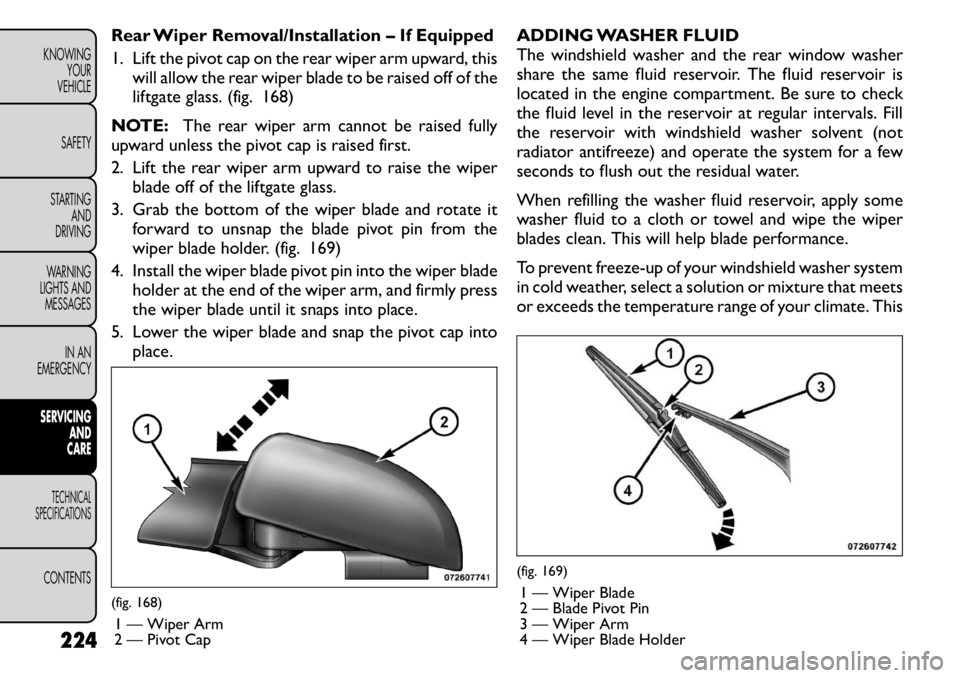
Rear Wiper Removal/Installation – If Equipped
1. Lift the pivot cap on the rear wiper arm upward, thiswill allow the rear wiper blade to be raised off of the
liftgate glass. (fig. 168)
NOTE: The rear wiper arm cannot be raised fully
upward unless the pivot cap is raised first.
2. Lift the rear wiper arm upward to raise the wiper blade off of the liftgate glass.
3. Grab the bottom of the wiper blade and rotate it forward to unsnap the blade pivot pin from the
wiper blade holder. (fig. 169)
4. Install the wiper blade pivot pin into the wiper blade holder at the end of the wiper arm, and firmly press
the wiper blade until it snaps into place.
5. Lower the wiper blade and snap the pivot cap into place. ADDING WASHER FLUID
The windshield washer and the rear window washer
share the same fluid reservoir. The fluid reservoir is
located in the engine compartment. Be sure to check
the fluid level in the reservoir at regular intervals. Fill
the reservoir with windshield washer solvent (not
radiator antifreeze) and operate the system for a few
seconds to flush out the residual water.
When refilling the washer fluid reservoir, apply some
washer fluid to a cloth or towel and wipe the wiper
blades clean. This will help blade performance.
To prevent freeze-up of your windshield washer system
in cold weather, select a solution or mixture that meets
or exceeds the temperature range of your climate. This(fig. 168)
1 — Wiper Arm
2 — Pivot Cap
(fig. 169)1 — Wiper Blade
2 — Blade Pivot Pin
3 — Wiper Arm
4 — Wiper Blade Holder
224
KNOWING
YOUR
VEHICLE
SAFETY
STARTING AND
DRIVING
WARNING
LIGHTS AND
MESSAGES
IN AN
EMERGENCYSERVICING AND
CARETECHNICAL
SPECIFICATIONSCONTENTS
Page 233 of 267
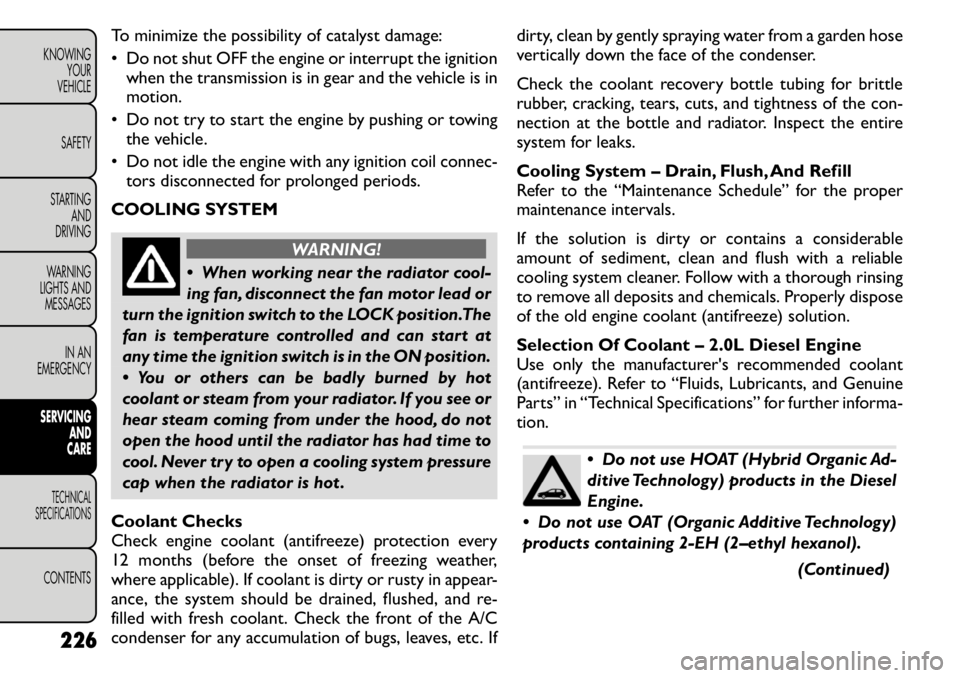
To minimize the possibility of catalyst damage:
• Do not shut OFF the engine or interrupt the ignitionwhen the transmission is in gear and the vehicle is in motion.
• Do not try to start the engine by pushing or towing the vehicle.
• Do not idle the engine with any ignition coil connec- tors disconnected for prolonged periods.
COOLING SYSTEM
WARNING!
When working near the radiator cool-
ing fan, disconnect the fan motor lead or
turn the ignition switch to the LOCK position.The
fan is temperature controlled and can start at
any time the ignition switch is in the ON position.
You or others can be badly burned by hot
coolant or steam from your radiator. If you see or
hear steam coming from under the hood, do not
open the hood until the radiator has had time to
cool. Never try to open a cooling system pressure
cap when the radiator is hot .
Coolant Checks
Check engine coolant (antifreeze) protection every
12 months (before the onset of freezing weather,
where applicable). If coolant is dirty or rusty in appear-
ance, the system should be drained, flushed, and re-
filled with fresh coolant. Check the front of the A/C
condenser for any accumulation of bugs, leaves, etc. If dirty, clean by gently spraying water from a garden hose
vertically down the face of the condenser.
Check the coolant recovery bottle tubing for brittle
rubber, cracking, tears, cuts, and tightness of the con-
nection at the bottle and radiator. Inspect the entire
system for leaks.
Cooling System – Drain, Flush, And Refill
Refer to the “Maintenance Schedule” for the proper
maintenance intervals.
If the solution is dirty or contains a considerable
amount of sediment, clean and flush with a reliable
cooling system cleaner. Follow with a thorough rinsing
to remove all deposits and chemicals. Properly dispose
of the old engine coolant (antifreeze) solution.
Selection Of Coolant – 2.0L Diesel Engine
Use only the manufacturer's recommended coolant
(antifreeze). Refer to “Fluids, Lubricants, and Genuine
Parts” in “Technical Specifications” for further informa-tion.
Do not use HOAT (Hybrid Organic Ad-
ditive Technology) products in the Diesel
Engine.
Do not use OAT (Organic Additive Technology)
products containing 2-EH (2–ethyl hexanol).
(Continued)
226
KNOWING YOUR
VEHICLE
SAFETY
STARTING AND
DRIVING
WARNING
LIGHTS AND
MESSAGES
IN AN
EMERGENCYSERVICING AND
CARETECHNICAL
SPECIFICATIONSCONTENTS
Page 234 of 267

(Continued)
Do not use plain water alone or alcohol base
engine coolant (antifreeze) products. Do not use
additional rust inhibitors or antirust products, as
they may not be compatible with the radiator
engine coolant and may plug the radiator.
This vehicle has not been designed for use with
Propylene Glycol based coolants. Use of Propyl-
ene Glycol based coolants is not recommended.
Adding Coolant – 2.0L Diesel Engine
Your vehicle has been built with an improved engine
coolant (antifreeze) that allows extended maintenance
intervals. This coolant can be used up to five years or
168 000 km before replacement. To prevent reducing
this extended maintenance period, it is important that
you use the same coolant throughout the life of your
vehicle.
Please note that it is the owner's responsibility to
maintain the proper level of protection against freezing
according to the temperatures occurring in the area
where the vehicle is operated.
NOTE: Mixing coolant types will decrease the life of
the engine coolant (antifreeze) and will require more
frequent coolant changes.
Cooling System Pressure Cap
The cap must be fully tightened to prevent loss of
coolant, and to ensure that coolant will return to the
radiator from the coolant recovery bottle. The cap should be inspected and cleaned if there is any
accumulation of foreign material on the sealing sur-
faces.
WARNING!
The warning words “DO NOT OPEN
HOT” on the cooling system pressure
cap are a safety precaution. Never add coolant
when the engine is overheated. Do not loosen or
remove the cap to cool an overheated engine.
Heat causes pressure to build up in the cooling
system. To prevent scalding or injury, do not re-
move the pressure cap while the system is hot or
under pressure.
Do not use a pressure cap other than the one
specified for your vehicle. Personal injury or en-
gine damage may result .
Disposal Of Used Coolant
Used ethylene glycol-based engine coolant is a regu-
lated substance requiring proper disposal. Check with
your local authorities to determine the disposal rules
for your community. To prevent ingestion by animals or
children, do not store ethylene glycol-based engine
coolant in open containers or allow it to remain in
puddles on the ground. If ingested by a child, contact a
physician immediately. Clean up any ground spills
immediately.
227
KNOWING
YOURVEHICLE SAFETY
STARTING ANDDRIVING
WARNING
LIGHTS AND
MESSAGES
IN AN
EMERGENCYSERVICING AND
CARETECHNICAL
SPECIFICATIONSCONTENTS
Page 235 of 267
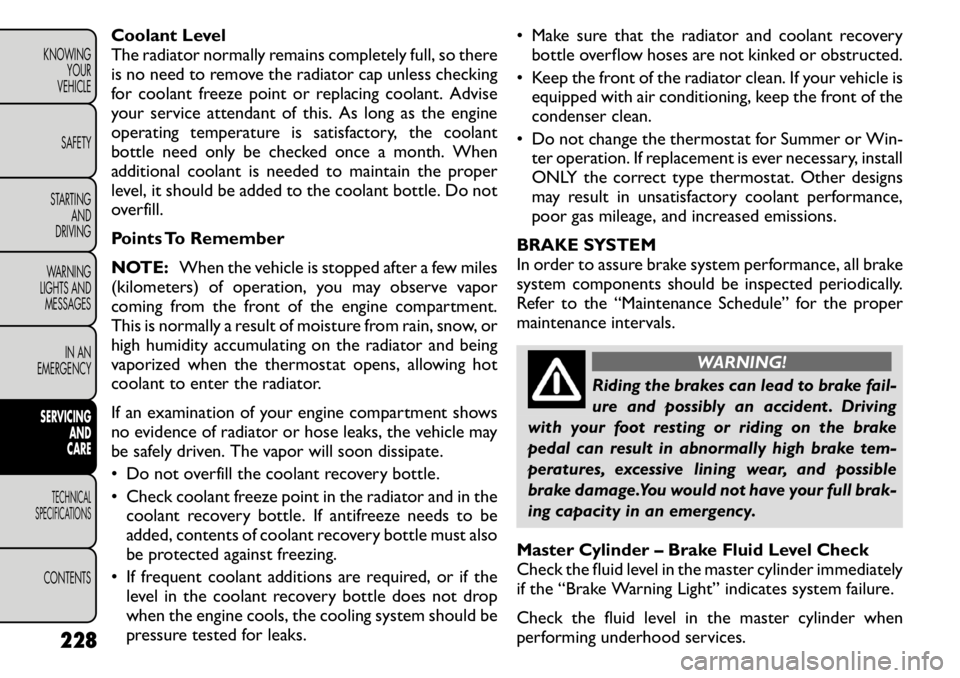
Coolant Level
The radiator normally remains completely full, so there
is no need to remove the radiator cap unless checking
for coolant freeze point or replacing coolant. Advise
your service attendant of this. As long as the engine
operating temperature is satisfactory, the coolant
bottle need only be checked once a month. When
additional coolant is needed to maintain the proper
level, it should be added to the coolant bottle. Do not
overfill.
Points To Remember
NOTE:When the vehicle is stopped after a few miles
(kilometers) of operation, you may observe vapor
coming from the front of the engine compartment.
This is normally a result of moisture from rain, snow, or
high humidity accumulating on the radiator and being
vaporized when the thermostat opens, allowing hot
coolant to enter the radiator.
If an examination of your engine compartment shows
no evidence of radiator or hose leaks, the vehicle may
be safely driven. The vapor will soon dissipate.
• Do not overfill the coolant recovery bottle.
• Check coolant freeze point in the radiator and in the coolant recovery bottle. If antifreeze needs to be
added, contents of coolant recovery bottle must also
be protected against freezing.
• If frequent coolant additions are required, or if the level in the coolant recovery bottle does not drop
when the engine cools, the cooling system should be
pressure tested for leaks. • Make sure that the radiator and coolant recovery
bottle overflow hoses are not kinked or obstructed.
• Keep the front of the radiator clean. If your vehicle is equipped with air conditioning, keep the front of the
condenser clean.
• Do not change the thermostat for Summer or Win- ter operation. If replacement is ever necessary, install
ONLY the correct type thermostat. Other designs
may result in unsatisfactory coolant performance,
poor gas mileage, and increased emissions.
BRAKE SYSTEM
In order to assure brake system performance, all brake
system components should be inspected periodically.
Refer to the “Maintenance Schedule” for the proper
maintenance intervals.
WARNING!
Riding the brakes can lead to brake fail-
ure and possibly an accident . Driving
with your foot resting or riding on the brake
pedal can result in abnormally high brake tem-
peratures, excessive lining wear, and possible
brake damage.You would not have your full brak-
ing capacity in an emergency.
Master Cylinder – Brake Fluid Level Check
Check the fluid level in the master cylinder immediately
if the “Brake Warning Light” indicates system failure.
Check the fluid level in the master cylinder when
performing underhood services.
228
KNOWING
YOUR
VEHICLE
SAFETY
STARTING AND
DRIVING
WARNING
LIGHTS AND
MESSAGES
IN AN
EMERGENCYSERVICING AND
CARETECHNICAL
SPECIFICATIONSCONTENTS
Page 236 of 267
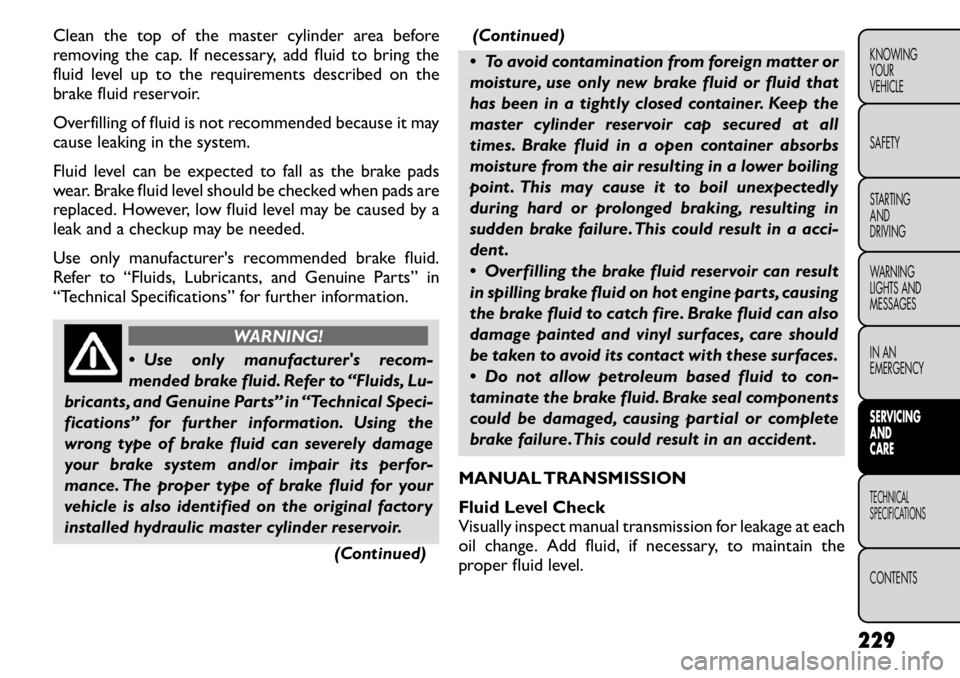
Clean the top of the master cylinder area before
removing the cap. If necessary, add fluid to bring the
fluid level up to the requirements described on the
brake fluid reservoir.
Overfilling of fluid is not recommended because it may
cause leaking in the system.
Fluid level can be expected to fall as the brake pads
wear. Brake fluid level should be checked when pads are
replaced. However, low fluid level may be caused by a
leak and a checkup may be needed.
Use only manufacturer's recommended brake fluid.
Refer to “Fluids, Lubricants, and Genuine Parts” in
“Technical Specifications” for further information.
WARNING!
Use only manufacturer's recom-
mended brake fluid. Refer to “Fluids, Lu-
bricants, and Genuine Parts” in “Technical Speci-
fications” for further information. Using the
wrong type of brake fluid can severely damage
your brake system and/or impair its perfor-
mance. The proper type of brake fluid for your
vehicle is also identified on the original factory
installed hydraulic master cylinder reservoir.
(Continued)(Continued)
To avoid contamination from foreign matter or
moisture, use only new brake fluid or fluid that
has been in a tightly closed container. Keep the
master cylinder reservoir cap secured at all
times. Brake fluid in a open container absorbs
moisture from the air resulting in a lower boiling
point . This may cause it to boil unexpectedly
during hard or prolonged braking, resulting in
sudden brake failure. This could result in a acci-
dent .
Overfilling the brake fluid reservoir can result
in spilling brake fluid on hot engine parts, causing
the brake fluid to catch fire. Brake fluid can also
damage painted and vinyl surfaces, care should
be taken to avoid its contact with these surfaces.
Do not allow petroleum based fluid to con-
taminate the brake fluid. Brake seal components
could be damaged, causing partial or complete
brake failure.This could result in an accident .
MANUAL TRANSMISSION
Fluid Level Check
Visually inspect manual transmission for leakage at each
oil change. Add fluid, if necessary, to maintain the
proper fluid level.
229
KNOWING
YOURVEHICLE SAFETY
STARTING ANDDRIVING
WARNING
LIGHTS AND
MESSAGES
IN AN
EMERGENCYSERVICING AND
CARETECHNICAL
SPECIFICATIONSCONTENTS
Page 254 of 267
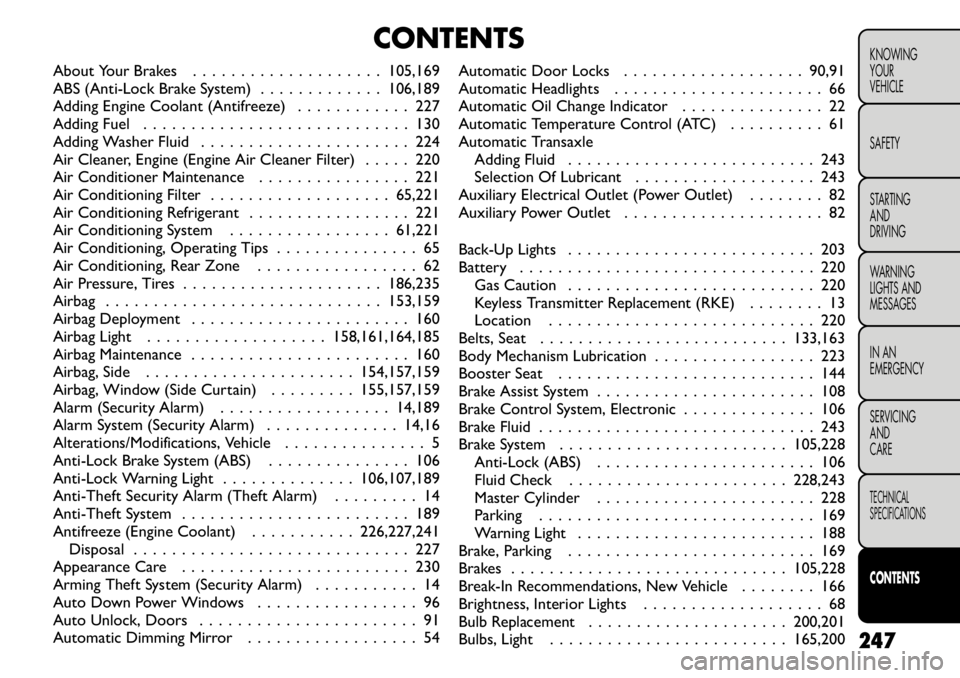
CONTENTS
About Your Brakes . . . . . . . . . . . . . . . . . . . . 105,169
ABS (Anti-Lock Brake System) . . . . . . . . . . . . . 106,189
Adding Engine Coolant (Antifreeze) . . . . . . . . . . . . 227
Adding Fuel . . . . . . . . . . . . . . . . . . . . . . . . . . . . 130
Adding Washer Fluid . . . . . . . . . . . . . . . . . . . . . . 224
Air Cleaner, Engine (Engine Air Cleaner Filter) . . . . . 220
Air Conditioner Maintenance . . . . . . . . . . . . . . . . 221
Air Conditioning Filter . . . . . . . . . . . . . . . . . . . 65,221
Air Conditioning Refrigerant . . . . . . . . . . . . . . . . . 221
Air Conditioning System . . . . . . . . . . . . . . . . . 61,221
Air Conditioning, Operating Tips . . . . . . . . . . . . . . . 65
Air Conditioning, Rear Zone . . . . . . . . . . . . . . . . . 62
Air Pressure, Tires . . . . . . . . . . . . . . . . . . . . . 186,235
Airbag . . . . . . . . . . . . . . . . . . . . . . . . . . . . . 153,159
Airbag Deployment . . . . . . . . . . . . . . . . . . . . . . . 160
Airbag Light . . . . . . . . . . . . . . . . . . . 158,161,164,185
Airbag Maintenance . . . . . . . . . . . . . . . . . . . . . . . 160
Airbag, Side . . . . . . . . . . . . . . . . . . . . . . 154,157,159
Airbag, Window (Side Curtain) . . . . . . . . . 155,157,159
Alarm (Security Alarm) . . . . . . . . . . . . . . . . . . 14,189
Alarm System (Security Alarm) . . . . . . . . . . . . . . 14,16
Alterations/Modifications, Vehicle . . . . . . . . . . . . . . . 5
Anti-Lock Brake System (ABS) . . . . . . . . . . . . . . . 106
Anti-Lock Warning Light . . . . . . . . . . . . . . 106,107,189
Anti-Theft Security Alarm (Theft Alarm) . . . . . . . . . 14
Anti-Theft System . . . . . . . . . . . . . . . . . . . . . . . . 189
Antifreeze (Engine Coolant) . . . . . . . . . . . 226,227,241 Disposal . . . . . . . . . . . . . . . . . . . . . . . . . . . . . 227
Appearance Care . . . . . . . . . . . . . . . . . . . . . . . . 230
Arming Theft System (Security Alarm) . . . . . . . . . . . 14
Auto Down Power Windows . . . . . . . . . . . . . . . . . 96
Auto Unlock, Doors . . . . . . . . . . . . . . . . . . . . . . . 91
Automatic Dimming Mirror . . . . . . . . . . . . . . . . . . 54 Automatic Door Locks . . . . . . . . . . . . . . . . . . . 90,91
Automatic Headlights . . . . . . . . . . . . . . . . . . . . . . 66
Automatic Oil Change Indicator . . . . . . . . . . . . . . . 22
Automatic Temperature Control (ATC) . . . . . . . . . . 61
Automatic Transaxle
Adding Fluid . . . . . . . . . . . . . . . . . . . . . . . . . . 243
Selection Of Lubricant . . . . . . . . . . . . . . . . . . . 243
Auxiliary Electrical Outlet (Power Outlet) . . . . . . . . 82
Auxiliary Power Outlet . . . . . . . . . . . . . . . . . . . . . 82
Back-Up Lights . . . . . . . . . . . . . . . . . . . . . . . . . . 203
Battery . . . . . . . . . . . . . . . . . . . . . . . . . . . . . . . 220
Gas Caution . . . . . . . . . . . . . . . . . . . . . . . . . . 220
Keyless Transmitter Replacement (RKE) . . . . . . . . 13
Location . . . . . . . . . . . . . . . . . . . . . . . . . . . . 220
Belts, Seat . . . . . . . . . . . . . . . . . . . . . . . . . . 133,163
Body Mechanism Lubrication . . . . . . . . . . . . . . . . . 223
Booster Seat . . . . . . . . . . . . . . . . . . . . . . . . . . . 144
Brake Assist System . . . . . . . . . . . . . . . . . . . . . . . 108
Brake Control System, Electronic . . . . . . . . . . . . . . 106
Brake Fluid . . . . . . . . . . . . . . . . . . . . . . . . . . . . . 243
Brake System . . . . . . . . . . . . . . . . . . . . . . . . 105,228 Anti-Lock (ABS) . . . . . . . . . . . . . . . . . . . . . . . 106
Fluid Check . . . . . . . . . . . . . . . . . . . . . . . 228,243
Master Cylinder . . . . . . . . . . . . . . . . . . . . . . . 228
Parking . . . . . . . . . . . . . . . . . . . . . . . . . . . . . 169
Warning Light . . . . . . . . . . . . . . . . . . . . . . . . . 188
Brake, Parking . . . . . . . . . . . . . . . . . . . . . . . . . . 169
Brakes . . . . . . . . . . . . . . . . . . . . . . . . . . . . . 105,228
Break-In Recommendations, New Vehicle . . . . . . . . 166
Brightness, Interior Lights . . . . . . . . . . . . . . . . . . . 68
Bulb Replacement . . . . . . . . . . . . . . . . . . . . . 200,201
Bulbs, Light . . . . . . . . . . . . . . . . . . . . . . . . . 165,200 247
KNOWING
YOURVEHICLE SAFETY
STARTING ANDDRIVING
WARNING
LIGHTS AND
MESSAGES
IN AN
EMERGENCY
SERVICING AND
CARETECHNICAL
SPECIFICATIONSCONTENTS
Page 255 of 267
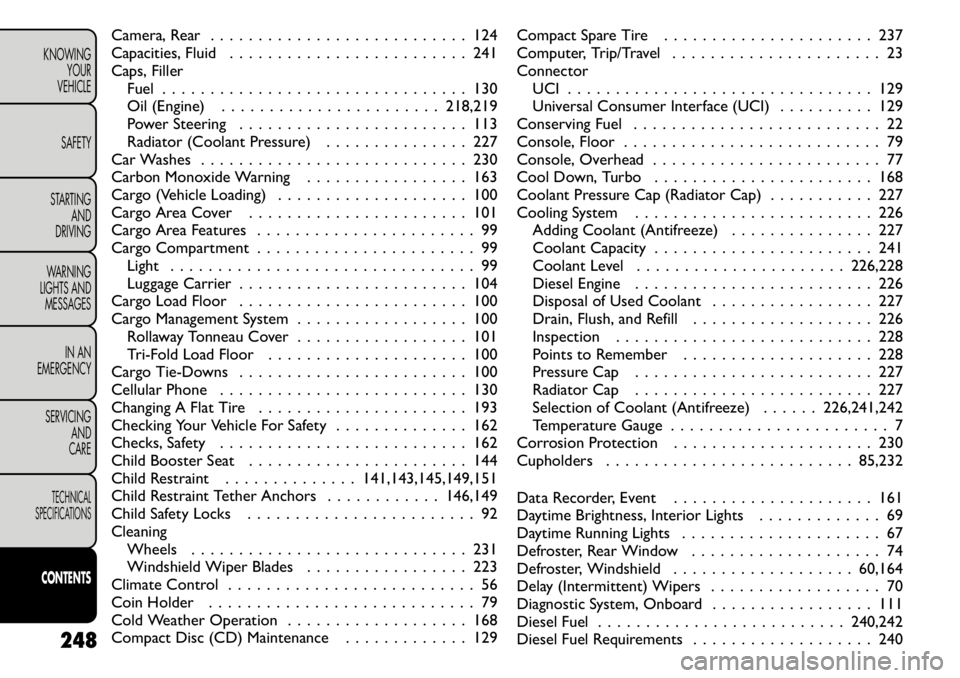
Camera, Rear . . . . . . . . . . . . . . . . . . . . . . . . . . . 124
Capacities, Fluid . . . . . . . . . . . . . . . . . . . . . . . . . 241
Caps, FillerFuel . . . . . . . . . . . . . . . . . . . . . . . . . . . . . . . . 130
Oil (Engine) . . . . . . . . . . . . . . . . . . . . . . . 218,219
Power Steering . . . . . . . . . . . . . . . . . . . . . . . . 113
Radiator (Coolant Pressure) . . . . . . . . . . . . . . . 227
Car Washes . . . . . . . . . . . . . . . . . . . . . . . . . . . . 230
Carbon Monoxide Warning . . . . . . . . . . . . . . . . . 163
Cargo (Vehicle Loading) . . . . . . . . . . . . . . . . . . . . 100
Cargo Area Cover . . . . . . . . . . . . . . . . . . . . . . . 101
Cargo Area Features . . . . . . . . . . . . . . . . . . . . . . . 99
Cargo Compartment . . . . . . . . . . . . . . . . . . . . . . . 99 Light . . . . . . . . . . . . . . . . . . . . . . . . . . . . . . . . 99
Luggage Carrier . . . . . . . . . . . . . . . . . . . . . . . . 104
Cargo Load Floor . . . . . . . . . . . . . . . . . . . . . . . . 100
Cargo Management System . . . . . . . . . . . . . . . . . . 100 Rollaway Tonneau Cover . . . . . . . . . . . . . . . . . . 101
Tri-Fold Load Floor . . . . . . . . . . . . . . . . . . . . . 100
Cargo Tie-Downs . . . . . . . . . . . . . . . . . . . . . . . . 100
Cellular Phone . . . . . . . . . . . . . . . . . . . . . . . . . . 130
Changing A Flat Tire . . . . . . . . . . . . . . . . . . . . . . 193
Checking Your Vehicle For Safety . . . . . . . . . . . . . . 162
Checks, Safety . . . . . . . . . . . . . . . . . . . . . . . . . . 162
Child Booster Seat . . . . . . . . . . . . . . . . . . . . . . . 144
Child Restraint . . . . . . . . . . . . . . 141,143,145,149,151
Child Restraint Tether Anchors . . . . . . . . . . . . 146,149
Child Safety Locks . . . . . . . . . . . . . . . . . . . . . . . . 92Cleaning Wheels . . . . . . . . . . . . . . . . . . . . . . . . . . . . . 231
Windshield Wiper Blades . . . . . . . . . . . . . . . . . 223
Climate Control . . . . . . . . . . . . . . . . . . . . . . . . . . 56
Coin Holder . . . . . . . . . . . . . . . . . . . . . . . . . . . . 79
Cold Weather Operation . . . . . . . . . . . . . . . . . . . 168
Compact Disc (CD) Maintenance . . . . . . . . . . . . . 129 Compact Spare Tire . . . . . . . . . . . . . . . . . . . . . . 237
Computer, Trip/Travel . . . . . . . . . . . . . . . . . . . . . . 23
Connector
UCI . . . . . . . . . . . . . . . . . . . . . . . . . . . . . . . . 129
Universal Consumer Interface (UCI) . . . . . . . . . . 129
Conserving Fuel . . . . . . . . . . . . . . . . . . . . . . . . . . 22
Console, Floor . . . . . . . . . . . . . . . . . . . . . . . . . . . 79
Console, Overhead . . . . . . . . . . . . . . . . . . . . . . . . 77
Cool Down, Turbo . . . . . . . . . . . . . . . . . . . . . . . 168
Coolant Pressure Cap (Radiator Cap) . . . . . . . . . . . 227
Cooling System . . . . . . . . . . . . . . . . . . . . . . . . . 226 Adding Coolant (Antifreeze) . . . . . . . . . . . . . . . 227
Coolant Capacity . . . . . . . . . . . . . . . . . . . . . . . 241
Coolant Level . . . . . . . . . . . . . . . . . . . . . . 226,228
Diesel Engine . . . . . . . . . . . . . . . . . . . . . . . . . 226
Disposal of Used Coolant . . . . . . . . . . . . . . . . . 227
Drain, Flush, and Refill . . . . . . . . . . . . . . . . . . . 226
Inspection . . . . . . . . . . . . . . . . . . . . . . . . . . . 228
Points to Remember . . . . . . . . . . . . . . . . . . . . 228
Pressure Cap . . . . . . . . . . . . . . . . . . . . . . . . . 227
Radiator Cap . . . . . . . . . . . . . . . . . . . . . . . . . 227
Selection of Coolant (Antifreeze) . . . . . . 226,241,242
Temperature Gauge . . . . . . . . . . . . . . . . . . . . . . . 7
Corrosion Protection . . . . . . . . . . . . . . . . . . . . . 230
Cupholders . . . . . . . . . . . . . . . . . . . . . . . . . . 85,232
Data Recorder, Event . . . . . . . . . . . . . . . . . . . . . 161
Daytime Brightness, Interior Lights . . . . . . . . . . . . . 69
Daytime Running Lights . . . . . . . . . . . . . . . . . . . . . 67
Defroster, Rear Window . . . . . . . . . . . . . . . . . . . . 74
Defroster, Windshield . . . . . . . . . . . . . . . . . . . 60,164
Delay (Intermittent) Wipers . . . . . . . . . . . . . . . . . . 70
Diagnostic System, Onboard . . . . . . . . . . . . . . . . . 111
Diesel Fuel . . . . . . . . . . . . . . . . . . . . . . . . . . 240,242
Diesel Fuel Requirements . . . . . . . . . . . . . . . . . . . 240
248
KNOWING
YOUR
VEHICLE
SAFETY
STARTING AND
DRIVING
WARNING
LIGHTS AND
MESSAGES
IN AN
EMERGENCY
SERVICING AND
CARETECHNICAL
SPECIFICATIONSCONTENTS